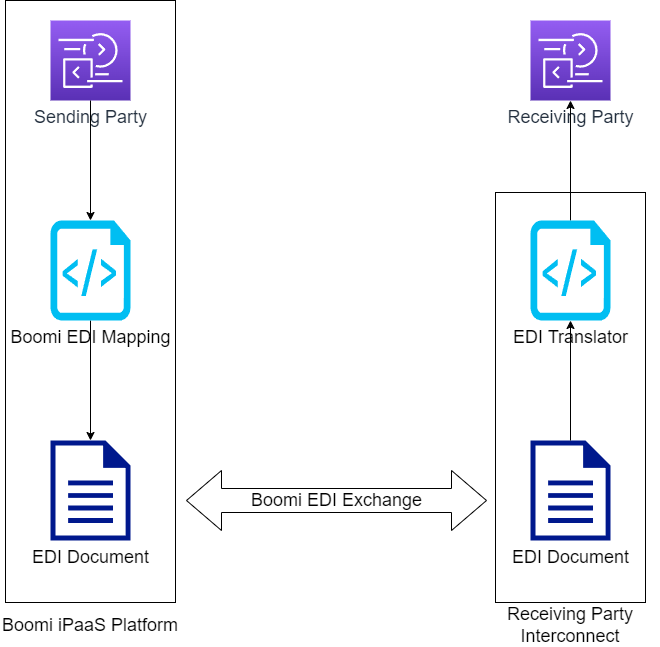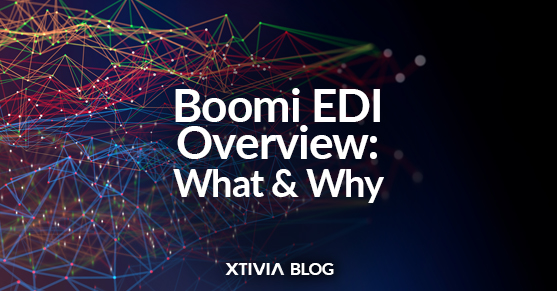This article introduces you to EDI, EDI Interconnects, traditional EDI Implementation, and Boomi EDI, and discusses the pros and cons of the traditional vs Boomi EDI implementation approaches.
What Is EDI?
Electronic Data Interchange (EDI) is the electronic interchange of business information using a standardized format, a process that allows one company to send information to another company electronically rather than with paper. It is widely used across the IT industry to exchange data and supports a range of different business units.
There are many different EDI standards that have been developed over the years, but these are the main ones that Boomi supports.
| Standard | Industry | Since |
| TRADACOMS | Retail | 1982 |
| ANSI X12 | Cross – Industry | 1983 |
| ODETTE | Automotive | 1986 |
| UN/EDIFACT | Cross – Industry | 1987 |
| RosettaNet (XML) | IT Supply Chain | 1998 |
What Are EDI Interconnects?
Traditionally the only way to exchange EDI data was via an EDI interconnect. These interconnects are companies that facilitate the exchange of EDI data. They handled the data encryption as well as the complex connectivity requirements between these segregated EDI systems. EDI interconnects also provide EDI implementation services that take the burden of knowing EDI standards and help organizations transform their internal data formats to EDI and vice versa. They bridge the gap between an organization’s internal data system that does not understand EDI to external EDI Trading Partners.
Traditional EDI Implementation
In the past, EDI implementation was very complex and relied on proprietary tools or expensive contracts with EDI interconnects. Due to the complexity of implementing EDI in-house, most businesses choose to outsource their EDI implementation to an EDI interconnect such as SPS Commerce. However, that came with some caveats.

| Pros | Cons |
| •Easier hands-off approach •EDI communication and maintenance is handled by the interconnect •No need for EDI knowledge as the interconnect handles the data mapping. | •Issues or changes (which happen frequently when working with multiple Trading Partners) require a support ticket and can take several weeks for a response and resolution. •EDI implementation is rigid and any deviation will require additional cost and implementation time. •Generally very expensive and is cost-prohibitive for small to medium-sized businesses. |
Boomi Business to Business (B2B)/EDI Management Module
The EDI Management Module does not come standard with the Boomi Integration Platform. It is an additional module that needs to be added, but it is very worthwhile. Here are the benefits of the Boomi EDI Module.
- Your own AS2 server that you can use to exchange EDI data with your trading partners.
- Data encryption using a signed AS2 certificate.
- Automatic Message Disposition Notification (MDN) with encryption and signing.
- Automatic 997 generation and delivery.
- The ability to set up multiple AS2 IDs for data exchange within your organization.
- FTP/SFTP and HTTPs communication support for EDI messaging.
- EDI profile setup and mapping support.
- Easy Trading Partner management.
- Each Trading Partner (TP) is an additional licensing cost. However, TP licenses are much cheaper than standard connector licenses.
There are also pros and cons to doing an EDI implementation within Boomi versus using an interconnect.
| Pros | Cons |
| •Cheaper than using an interconnect and allows small to medium size businesses to leverage the benefits of using EDI. •Agile EDI development that can accommodate multiple EDI standards and deviations. •Faster resolution time for issues and mapping changes leading to a better business workflow. •The ability to have one integration platform handle all electronic data intake/output (EDI, XML, JSON, Flat File). Reusable mapping and components that allow for faster EDI implementation & onboarding. •Easier debugging and traceability when there are issues with EDI communication. •Better visibility into EDI metrics. •Direct connectivity from Boomi AS2 to an EDI Value Added Network (VAN). •Performance monitoring and room for server scalability to meet the needs of the business. | •Requires Boomi resources with an understanding of EDI standards and Boomi implementation of EDI. •Maintenance is done in-house instead of by the Interconnect (i.e., Certificate expiration and updates). •Requires a load balancer with networking setup when using multiple Boomi nodes such as a molecule. •No VAN to VAN connectivity as Boomi AS2 server is not a VAN, but Boomi AS2 servers can communicate with a VAN directly |

The main cons to doing EDI within Boomi is that it requires Boomi resources who are familiar with both EDI and Boomi, which can be hard to come by. XTIVIA has been doing EDI implementation within Boomi for years and can help answer any questions your organization might have.
Please get in touch with us to learn how we can help with your Boomi EDI implementation as your Boomi partner or if you simply have Boomi questions.
Check out our other blog posts for more information about Boomi EDI implementation.
Boomi AS2 EDI Server Networking

